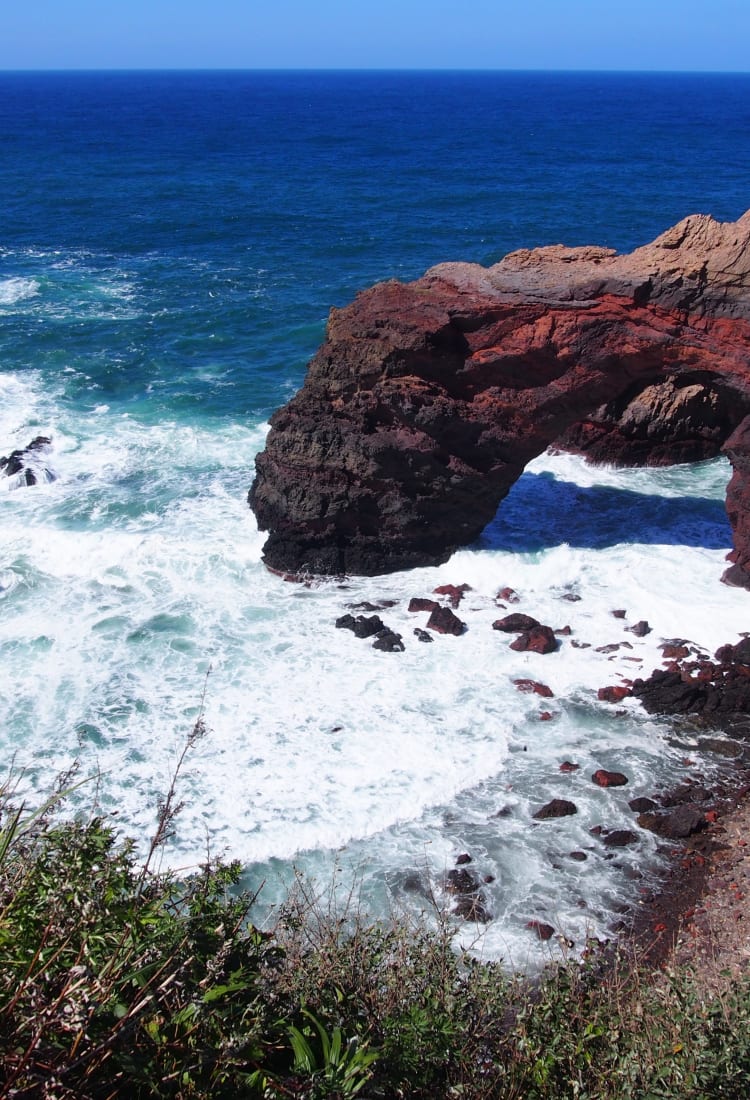

SHIMANE Oki Islands Islands off the Japanese archipelago with unique ecosystems
Islands off the Japanese archipelago with unique ecosystems
Part of the Daisen-Oki National Park and recognized as a UNESCO Global Geopark since 2013, only four of the 180-odd Oki Islands are inhabited.

Don't Miss
- Sunset views over Rosoku-jima (Candle Island)
- Hiking along the impressive Kuniga Coast
- Enjoying seafood from the surrounding waters
How to Get There
Access to the Oki Islands is restricted to sea and air. Once on the island you can rent a car, take a local taxi or rent a bicycle.
Ferry services are available from Shichirui Port in Matsue City and Sakaiminato Port in Sakaiminato City, Tottori Prefecture. The ferry journey takes about 2.5 hours. Ferry services are increased in the summer months and reduced in the winter months, so check the timetable before departure. There are also much shorter fast boat services from both ports. Always check the Oki Kisen homepage for current information.
Oki Airport on Dogo is served by flights from Osaka International Airport,which take 50 minutes, and Izumo Airport, which takes 30 minutes.
Ferries connect all four islands. Bus services are limited, so renting a car gives you more freedom to visit the sites. There is also the option of renting a bicycle to get around.
Beaches, coasts and seas
The waters surrounding the Oki Islands are exceptionally clear, perfect for water-based activities and leisure pursuits such as swimming, snorkelling, kayaking, and fishing. You can take scuba diving lessons or, if experienced, rent gear and dive solo.
Much of the rugged coastline is perfect for walking and strolling. The grassy slopes of Matengai Cliff are 257 meters above the surf. Don't miss the view of the sunset at the tip of Candle Island (Dogo Island).
For those looking for something more strenuous, hike Mt. Daimanji—more than 600 meters above sea-level. This mountain has many hiking trails where the ancient deities of the forest are still worshipped.
Alternatively, hike up to the top of Mt. Takuhi. From the summit of this 450 meter-high mountain, you can look out over the blue see and surrounding islands.
Bus traffic is almost non-existent, making cycling safe and comfortable. Renting a bicycle is a convenient way to tour the islands and enjoy the scenery.
Cruising around
Alternative itineraries include exploring the coastline from the sea on one of the numerous organized boat tours.
The glass underwater viewing boat, Amanbow reveals the world below the sea. A cruise across the canal which was built to open up the isthmus between Nishino Island and the scenic Kuniga coast offers the opportunity to understand the local way of life and the spectacular topography of the area.
An island introduction
Dogo is the largest of the Oki Islands, with a circumference of about 211 kilometers. The Shirashima Coast, the Jodogaura Coast and Candle Island —where the suns seems to set on the tip of the 20 meter-high spire of rock rising from the sea—are just a few natural highlights.
Venture inland for Dangyo Shrine and Dangyo Falls , or see the 800 year-old Chichi-sugi Japanese Cedar, a massive, strangely shaped tree.

Nishinoshima, with around 3,000 inhabitants, is the second largest of the inhabited islands and home to Kuniga Coast.
Visit Takuhi-jinja Shrine , a shrine built inside a cave high inside a volcano, overlooking the surrounding seas. Yurahime-jinja Shrine was built facing an inlet, and legend has it that the sandy beach was covered with schools of squid between December and New Year's Day. Watch rituals at these shrines and other places around the islands.
The smaller islands
Nakanoshima is the lowest-lying of the islands, with a high point of 246 meters at Mt. Atodo. Its long coastline includes the red cliffs of Akiya, which stretches for 1 kilometer. Visitors can enjoy views of the other islands from Cape Kirogasaki Lighthouse.
Emperor Gotoba spent the last 19 years of his life in exile on Nakanoshima at the beginning of the 13th century. It is said that the Oki tradition of Bull Sumo , still popular today, began here as entertainment for him. The underwater exploration boat called the Amanbow departs from here.
Home to only 600 people, the tiniest of the inhabited islands is Chiburijima. The land is rugged, making it difficult to make a living from agriculture. This small island is home to some impressive sights, such as the view of the Oki Islands from the top of Mt. Akahage, or the striking red rocks of Sekiheki (Red Cliff).






























































